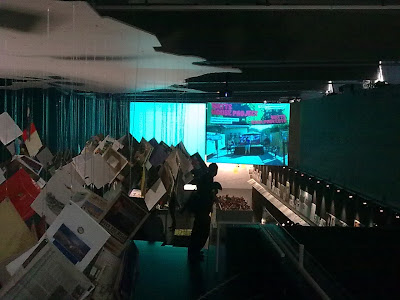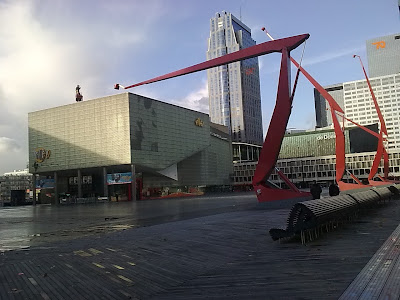if there was a theme through all my fever films over the past few days holed up at home it must be the possibility of another place that always exists.
away from the perpetually dark city that transmogrifies every night into a new configurations- where identities are erased and reassigned is ‘shell city’- on a postcard and a billboard; and as an enormous poster on the edge of the city- beyond which is nothing. a bikini clad woman mechanically waves at us to join her in the sunlight and to walk in the waves. the perpetually shifting city rebuilds itself every night but this other place always stays. away.
all joy and laughter and pretty petty little things make up the musical ‘meet me is st louis’. in idyllic suburban st louis where the biggest show in the universe is being readied – the worlds fair. the two sisters vie to get married to their respective beaus as new york plays the part of the other place pulling them away just as their dreams begin to take shape. the big city where they will live in a flat away from everything that they know can never replace the pastoral friendliness of the small town that is anyway soon going to be the center of the world with its dazzling display of electric pavilions and neo classical splendor. judy garland’s voice quivers in the gorgeous ‘have yourself a merry little christmas’.
in a very different context- this time the steppes of kazakhstan- the theme is echoed. the suburban house is now a yurt where asa lives with his wife, her husband and their kids. his dream is drawn on the collar of his soldiers uniform. it is a yurt in the desolate landscape lit by the sun and the stars. tulpan is the girl he needs to marry to set up home and whom he will never have. the only eligible girl on the steppe. the city and the port where busty women will have their way with him and where he can be free (and has been) holds no interest for him. he has seen the world and settles instead for the dust storms, the sheep and the news of the world recited to him by his nephew rote from radio kazakh. stunning landscapes and lovely film.
‘a christmas tale’ was all it might have been if it was a hollywood weepie starring, i don’t know, diane keaton (?) as the dying matriarch whom the entire family gathers around to support and donate bone marrow to so that she survives. except that it was not. catherine deneuve plays the dying mother of a completely dysfunctional but strangely lovable family. a sister has banished a brother from the family and the mother has almost no capability of affection. more bergman than spielberg.
in code 46 delhi is a place for bat specialists and in shanghai in a sterile building called the ‘sphinx’ a woman is making fake ids for people to get out. an investigator who can read minds with a empathy drug finds her out and falls in love with her only to discover that she shares exactly the same dna as his mother. but more than the tale of love torn apart by the horrors of biotechnology gone mad, the landscapes were fantastic- the desert outside shanghai, the dark liquid lit city and the grubbiness of the ‘outside’ where people fall once they don’t follow the rules.
does solo live in this outside? a taxi driver originally from senegal in small town american where he meets william – another man on the edge of the american dream- who long for his family under cover. like ‘ a taste of cherry’ the pact is for the solo to drive william to a place outside the city where he is going to kill himself. solo find himself again in his family though and william disappears.
the ideal place for future man is an island. in ‘the possibility of an island’ the story of a very human comedian is told juxtaposed with those of his exact clones who have descended from him. they sit alone in a room surrounded by an empty landscape listening to the life of their ancestor- with its sexual obsessions, jealousies and fear of loneliness and death. eternal life has to be an island.
more novels: ‘the city and the pillar’ gore vidal’s really not that controversial gay love story. it seems so tame today but it must have created a furor when it was released. murakami’s ‘the wind up bird chronicle’ whose surreal intertwining stories make profound metaphors of everyday objects- like the deep well in which he finds himself. outrageous and hilarious is ‘duluth’ – another gore vidal. here two women die in a car caught in a snowdrift. one is reborn as a tv star who remembers who she was in her earlier avatar and the other as the heroine of a harlequin romance. somewhere along the way the narrative also picks up a sadistic blonde policewoman who likes to shave the pubic hair of mexican immigrant and a red spaceship shaped like a tack on the map of the city.



















































































































